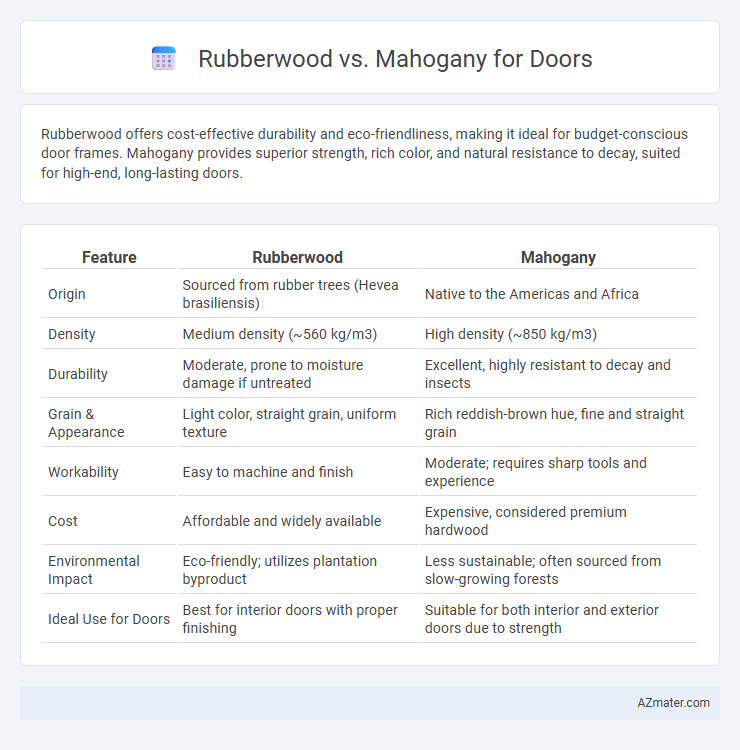Rubberwood offers cost-effective durability and eco-friendliness, making it ideal for budget-conscious door frames. Mahogany provides superior strength, rich color, and natural resistance to decay, suited for high-end, long-lasting doors.
Table of Comparison
| Feature | Rubberwood | Mahogany |
|---|---|---|
| Origin | Sourced from rubber trees (Hevea brasiliensis) | Native to the Americas and Africa |
| Density | Medium density (~560 kg/m3) | High density (~850 kg/m3) |
| Durability | Moderate, prone to moisture damage if untreated | Excellent, highly resistant to decay and insects |
| Grain & Appearance | Light color, straight grain, uniform texture | Rich reddish-brown hue, fine and straight grain |
| Workability | Easy to machine and finish | Moderate; requires sharp tools and experience |
| Cost | Affordable and widely available | Expensive, considered premium hardwood |
| Environmental Impact | Eco-friendly; utilizes plantation byproduct | Less sustainable; often sourced from slow-growing forests |
| Ideal Use for Doors | Best for interior doors with proper finishing | Suitable for both interior and exterior doors due to strength |
Introduction: Rubberwood vs Mahogany for Doors
Rubberwood and mahogany are two popular materials used in door manufacturing, each offering distinct qualities. Rubberwood, derived from the Para rubber tree, is known for its eco-friendliness, affordability, and light color, making it suitable for modern, budget-conscious interiors. Mahogany is prized for its rich, deep reddish-brown hue, exceptional durability, and natural resistance to decay, often chosen for premium, elegant doors.
Origin and Source of Rubberwood and Mahogany
Rubberwood, primarily sourced from the Para rubber tree (Hevea brasiliensis), is native to Southeast Asia, particularly Malaysia and Thailand, where it is harvested from plantation trees after latex production ends. Mahogany, originating from tropical regions in Central and South America, especially Honduras and Belize, is known for its hardwood quality and has been historically prized in fine woodworking and premium door manufacturing. The sustainable sourcing of rubberwood from plantation trees offers an eco-friendly alternative to traditional mahogany, which faces challenges due to deforestation and regulated harvesting.
Physical Appearance and Grain Patterns
Rubberwood features a pale cream to light brown color with a consistent, straight grain pattern that offers a clean and modern look ideal for door applications. Mahogany displays a rich reddish-brown hue with a more pronounced, interlocking grain and occasional swirls, creating a luxurious and classic aesthetic. The smoother texture of rubberwood contrasts with mahogany's natural luster, making the choice dependent on desired style and finish for doors.
Durability and Strength Comparison
Rubberwood offers moderate durability with good resistance to wear but is generally less dense and softer compared to mahogany. Mahogany is renowned for its superior strength, high durability, and excellent resistance to decay, making it ideal for doors that require long-lasting performance and structural integrity. Choosing mahogany over rubberwood ensures enhanced stability and longevity, especially in high-traffic or exterior door applications.
Resistance to Moisture and Pests
Rubberwood offers moderate resistance to moisture but requires proper sealing and treatment to prevent swelling and warping, making it less ideal for high-humidity environments compared to mahogany. Mahogany boasts superior natural resistance to moisture and pests due to its dense grain and natural oils, ensuring enhanced durability and longevity for doors in varying climatic conditions. Choosing mahogany reduces the risk of termite and fungal damage, while untreated rubberwood remains more vulnerable without protective finishes.
Environmental Impact and Sustainability
Rubberwood, sourced from plantation-grown rubber trees after latex extraction, is highly sustainable due to its fast growth and waste reduction in the rubber industry, making it an eco-friendly choice for doors. Mahogany, a slower-growing hardwood often harvested from tropical rainforests, faces significant environmental concerns related to deforestation and habitat loss, impacting its sustainability negatively. Choosing rubberwood over mahogany for doors supports responsible forestry practices and reduces ecological footprint.
Cost and Affordability
Rubberwood is significantly more affordable than mahogany, making it a popular choice for budget-conscious door projects. Mahogany's higher cost reflects its superior durability and rich aesthetic, often reserved for premium or luxury doors. Choosing rubberwood offers excellent cost-efficiency while maintaining sufficient strength and appearance for standard interior doors.
Ease of Workability and Finishing
Rubberwood offers superior ease of workability due to its lighter density and consistent grain, making it ideal for intricate door designs and smooth sanding. Mahogany, although harder and denser, provides a rich, deep finish that enhances the door's aesthetic but requires more effort in cutting and finishing. Finishing rubberwood is simpler with faster absorption of stains, whereas mahogany demands careful sealing to achieve its signature lustrous finish.
Maintenance and Longevity
Rubberwood doors require regular sealing and polishing to prevent moisture damage and maintain durability, while mahogany doors naturally resist rot and insects, reducing maintenance needs. Mahogany's dense grain contributes to exceptional longevity, often lasting decades with minimal upkeep compared to rubberwood. Choosing mahogany ensures superior long-term investment in door quality and performance.
Best Applications: Which Wood to Choose for Your Door?
Rubberwood offers durability and affordability, making it ideal for interior doors in residential spaces where cost-efficiency and environmental sustainability are priorities. Mahogany provides exceptional strength, rich color, and natural resistance to decay, perfect for high-end exterior doors that require long-lasting weather resistance and an elegant appearance. Choose rubberwood for budget-friendly, eco-conscious projects and mahogany for premium, architecturally demanding doors exposed to outdoor elements.

Infographic: Rubberwood vs Mahogany for Door
 azmater.com
azmater.com